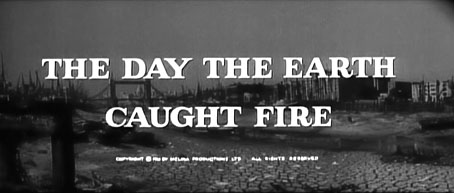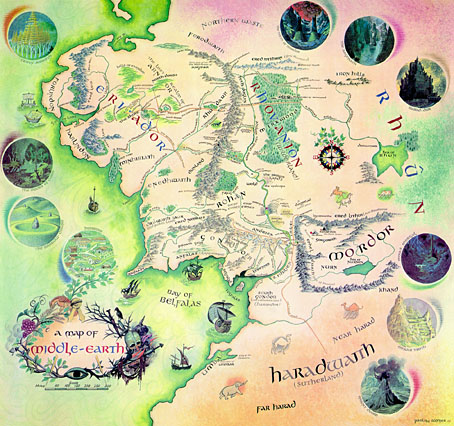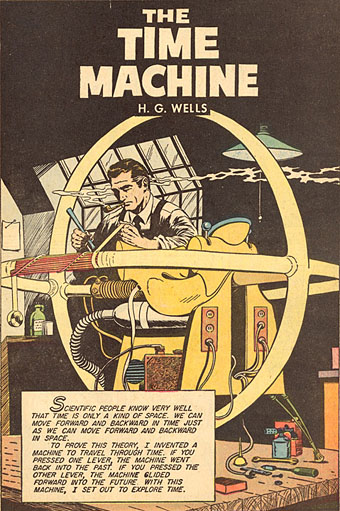Tag: HG Wells
Edward Judd, 1932–2009
Like the creations of the late Oliver Postgate, Edward Judd haunts my childhood imagination via the handful of very British science fiction and sf/horror movies he starred in during the 1960s. He did a great deal of acting before and after this—in the Seventies he was a very ubiquitous TV character actor—but it’s his run of genre films which remains notable. In these roles he was always the stalwart Everyman, usually with another older actor as co-star who supplies the requisite scientific explanations.
The first of these, The Day the Earth Caught Fire (1961), was a Val Guest production which followed the success of Guest’s Quatermass films in visiting another space-born calamity upon the world, this time an unprecedented heatwave caused by nuclear tests which throw the earth off its orbit. The film opens with a Ballardesque view of the River Thames parched to a thin stream, and features some great shots later of Judd stumbling through an abandoned, dust-strewn capital. The location work in the Daily Express building on Fleet Street adds to the realism, as does a strong script and decent performances.
The Panic Broadcast

It was 70 years ago today—October 30, 1938—that Orson Welles and the Mercury Theatre traumatised American radio listeners with their brilliant adaptation of The War of the Worlds. I wrote about that recording last year so rather than repeat myself, here’s the final words from Howard Koch’s 1970 book about the play, The Panic Broadcast. (That’s the cover of my cheap paperback edition.) Koch was charged by Welles and producer John Houseman with the task of condensing and updating HG Wells’ novel and he ends his book with an examination of the lessons to be learned from the resulting hysteria. America’s current crop of demagogues on TV and radio—and the audiences prepared to take everything they say at face value—render his words as apposite now as they were forty years ago.
Meanwhile, how can we protect ourselves from politically biased information coming to us through the mass media? It isn’t as simple as dialing another station as in the case of the Martian scare. In my opinion, the only safeguard we have is the cultivation of a skeptical attitude toward all authority, to regard no person or office sacrosanct, to accept nothing that doesn’t accord with our experience and our knowledge acquired from other sources.
Most of my generation were brought up to give unquestioned obedience to authority, whether parental, religious or political. The result has been a compliant and conformist society that has tolerated a war every decade, all sorts of racial and economic inequities and a progressive spoliation of our planet. The management, shall we say, has been less than perfect.
But for the first time there are signs of a change and we have good reason to hope that the world won’t be lost by default. Today all authority is being questioned and challenged, especially by the young. The American people have become more concerned with public affairs on every level. They are taking less on faith; the individual intelligence is beginning to assert itself in self-protection and therein lies the promise of a society with the attributes for survival.
If the nonexistent Martians in the broadcast had anything important to teach us, I believe it is the virtue of doubting and testing everything that comes to us over the airwaves and on the printed pages – including those written by the author of this book.
• The Mercury Theatre on the Air | An archive of the radio shows
Previously on { feuilleton }
• The night that panicked America
• War of the Worlds book covers
Pauline Baynes, 1922–2008
Pauline Baynes, who died earlier this week, was for a long while the only Tolkien illustrator of note. Her work was approved by Tolkien himself but faded from view as the JRRT spin-off industry began to expand in the late Seventies and other artists quickly crowded the field, many of whom lacked her subtlety and sympathy for the material. It was her artwork which Allen & Unwin used on their single-volume edition of Lord of the Rings and in the late Sixties they also produced a poster of her Middle Earth map (above; complete version here). That poster hung on my bedroom wall and fascinated me with its view of the now over-familiar characters and the vignette details of various locations.
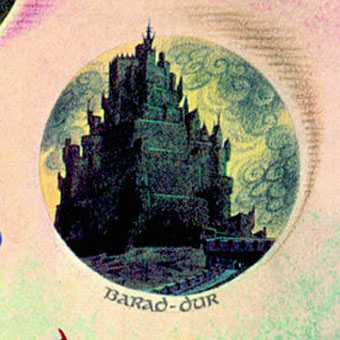
Those vignettes, such as her tiny rendering of Sauron’s Dark Tower, seemed at the time a perfect summation of Tolkien’s world and I still prefer her hulking Barad-dûr to the spiny monolith seen in Peter Jackson’s films. Her friendship with Tolkien led to a similar commission for maps and illustrations from CS Lewis and it’s as the illustrator of the Narnia books that she’s most celebrated. I never read Lewis’s work, and came to Lord of the Rings late, so the infatuation with this brand of heroic fantasy swiftly gave way to the ambivalent moralities of Michael Moorcock‘s Elric, Fritz Leiber‘s Lankhmar and Mervyn Peake’s Gormenghast. Her work wouldn’t have suited those writers but for Tolkien and Lewis she was ideal.
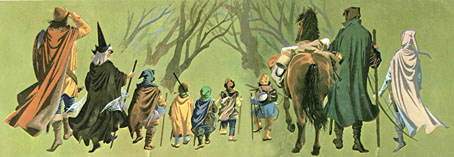
The Fellowship of the Ring from the Middle Earth map.
One of the newspaper obituaries notes:
It was somewhat to her chagrin that she developed a reputation over the years as an illustrator of mostly Christian works and, to redress the balance, one of her last creations (her “children” as she called them) was a series of designs for selections from the Qur’an, scheduled for publication in 2009.
These days Charles Williams is the writer who interests me still from the Oxford group known as “the Inklings”, of whom Tolkien and Lewis were the most famous members. Williams was also a Christian propagandist but his use of fantasy was more sophisticated and, in the extraordinary Many Dimensions (1931), he too managed to depart from the Christian sphere by blending HG Wells-style science fantasy with Islamic mysticism.
Brian Sibley wrote a Pauline Baynes obituary for The Independent and his blog features an excellent overview of her life and work.
Elsewhere on { feuilleton }
• The illustrators archive
Previously on { feuilleton }
• Mervyn Peake in Lilliput
HG Wells in Classics Illustrated
Complete scans of War of the Worlds (1955) and The Time Machine (1956), both adapted by Lou Cameron.
Previously on { feuilleton }
• The night that panicked America
• The Door in the Wall
• War of the Worlds book covers

